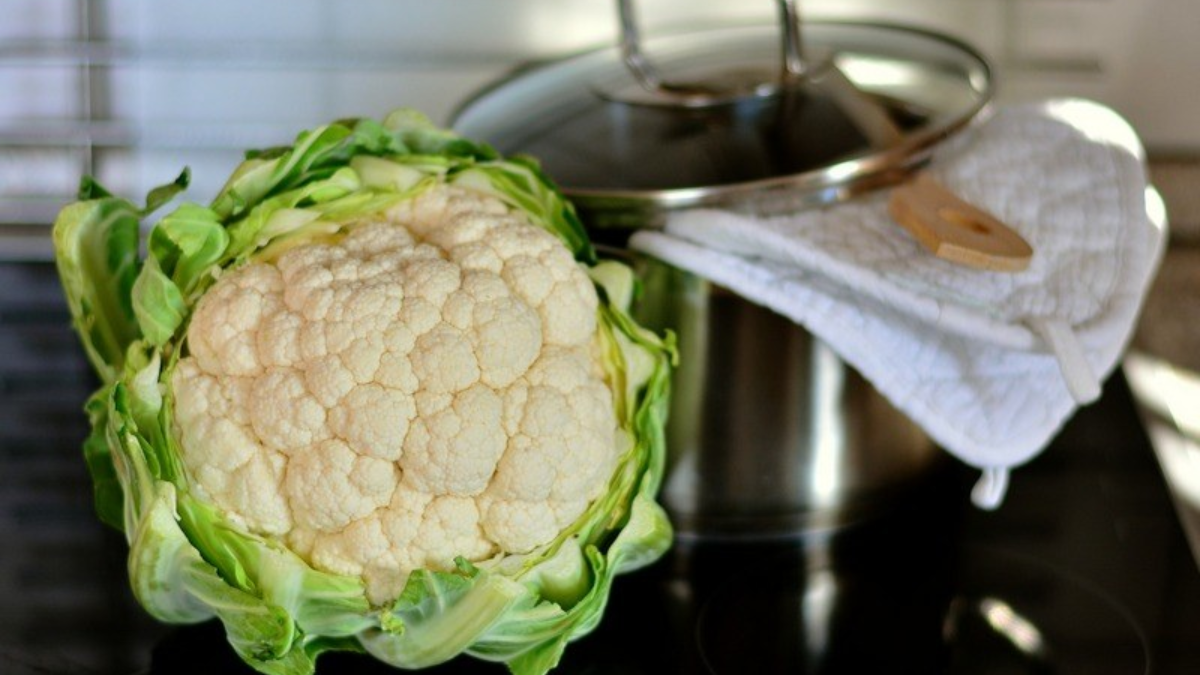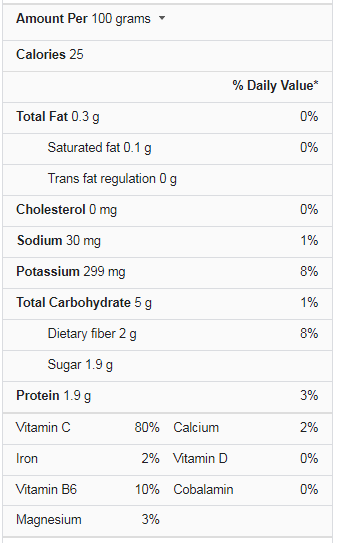Similar in appearance to broccoli and equally remarkable is cauliflower. Cauliflower is a pleasantly flavorful white vegetable member of the brassica family. Choose cauliflowers with pure white heads that are free of discoloration and crisp green leaves so that you may enjoy their fantastic taste with the rest of your dinner. The more white the base, the fresher it is, which indicates when it was harvested.
Depending on the size and freshness of the florets, cauliflower cooking time varies. To avoid overcooking the cauliflower, boil it for five to ten minutes (or perhaps a little longer if it’s frozen) until it’s fork-tender. It gets softer and mushier as it cooks for a more extended period. After draining it, combine it with salt, pepper, butter, cooking oil, and any additional herbs and spices you choose. Thyme and garlic powder also works well to add flavor, as may curry powder, chili powder, or Cajun seasoning.
Cauliflower Nutrition Facts
What is Cauliflower?
A vegetable known as a crucifer is cauliflower, and it belongs to the mustard family and is known as its cousin broccoli, Brussels sprouts, kale, and radishes. The Latin root of the term “cauliflower” means “flowers of cabbage,” This low-growing plant resembles cabbage until the broad leaves start to open up. This displays the globe-shaped, six to eight-inch-diameter head, which is cream in color. Bumpy florets joined to the main stem from the head.
The florets are separated from the harvested cauliflower head and used in several cuisines. Fresh cauliflower is simple to prepare, although unraveling the head’s florets requires a bit extra work. Raw cauliflower is frequently dipped because it is crisp and can have a relatively strong bite, and cauliflower tastes slightly sweet and nutty when cooked correctly.
How to Boil Cauliflower?
Here is the best boil cauliflower recipe:
Ingredients
- One head cauliflower
- 1-quart water or enough water to cover the cauliflower
- 1 tbsp salt
- 2 tbsp butter melted
- 1/2 tsp garlic powder
- 1/2 tsp onion powder
- salt and pepper to taste
Instructions
Here are the instructions to follow:
-
Remove the florets from the cauliflower and set the stalks aside for other use.
-
Place the cauliflower into a medium-sized saucepan and cover it with water. Add more water if 1 quart doesn’t cover all of the pieces.
-
Add 1 tbsp of salt to the water. Heat on high for 5-7 minutes until the water is simmering.
-
Allow to simmer for 5-7 minutes, then check the cauliflower by piercing it with a fork. If you are using this cauliflower for another cooked recipe, then the fork should barely pierce the exterior of the cauliflower. If you plan to eat the cauliflower as is, boil it until a knife goes quickly through the entire piece (10 minutes or so).
-
While the cauliflower is cooking, melt butter in a small saucepan, add garlic powder and onion powder to the butter, and stir well. Turn the heat off when the butter is fully melted.
-
When cauliflower is cooked the way you want, pour it into a colander to drain initially, then place it on paper towels to drain on paper towels.
-
Once drained place in a bowl and pour the melted butter mixture over the top. Taste and add salt and pepper.
-
Serve hot.
Tips
- If you plan to eat right away, you will want your cauliflower more tender (so the fork quickly goes through the entire piece).
- Are you using it in a recipe that will be cooked more? Then only boil it until a fork can pierce the cauliflower but doesn’t want to go entirely through.
- Cauliflower is brittle when raw; it breaks easily and can not be pierced with a fork (it will split and crumble).
- When cooked, you will notice slightly different turns, a greenish pearly translucent color. This is normal.
- Save the water you boiled the cauliflower in if you make a sauce, it can be used to thin and flavor the sauce.
Selecting and Storing Fresh Cauliflower
The first step in preparing cauliflower as an excellent dish is selecting the best cauliflower and handling it appropriately.
- Look for a solid cauliflower with curds that are uniformly ivory in color and securely compacted, whether you are purchasing a complete head or a package of precut florets. There should be no moist or stained brown areas on the florets.
- A complete head should have evenly spaced florets, healthy green leaves, and no odor. For its size, it should feel substantial.
- Cauliflower heads should be stored in the vegetable drawer in an open or perforated plastic bag for refrigeration. It is best to wait to wash it until you are ready to use it because moisture speeds up spoilage and can cause mold to grow.
- Cauliflower precut packaging should be kept sealed until used. While precut florets often only have a shelf life of a few days, whole heads should keep for several days to a week.
If you don’t use all of your raw cauliflower in time, you may freeze it, but it must first be chopped and blanched. Bring to a boil enough water that is just salted enough to cover the cauliflower. The florets should be added, cooked for three minutes, drained, and then immediately placed in a bowl or pot of ice water to stop the cooking process. Dry them thoroughly before freezing them in an airtight freezer bag or container.
How Healthy is Cauliflower?
Here are some health benefits of cauliflower:
Cauliflower May Help Reduce your Risk of Cancer
Cauliflower is a cruciferous vegetable similar to broccoli, kale, Brussels sprouts, cabbage, collard greens, radishes, and turnips. These vegetables include glucosinolates, which are sulfur-containing molecules with a pungent smell. Even if some individuals dislike the scent, continue to eat your vegetables because those substances may help lower your risk of developing several types of cancer. Because the results of human studies have been conflicting thus far, researchers are still looking into the possible anticancer qualities of cruciferous vegetables.
Cauliflower is Great for your Gut
The inner lining of the large intestine and the rectum are affected by inflammatory bowel illnesses, including ulcerative colitis. Consuming cauliflower can improve intestinal health and reduce your risk of getting these conditions. (Since ulcerative colitis is incurable, your best hope is to try to avoid it by eating a healthy diet.) Cauliflower’s anti-inflammatory characteristics may protect against various chronic illnesses, including cancer.
Cauliflower is Chock-Full of Vitamins & Other Nutrients.
One serving of cauliflower contains around 8% of your daily recommended fiber intake, along with folate, vitamin C, and potassium. You can obtain additional advantages from only a cup of chopped cauliflower, including vitamin A, thiamine, riboflavin, niacin, calcium, iron, and phosphorus. 4% of your daily protein requirements are also found in cauliflower.
Cauliflower May Help Boost your Immune Function
Cauliflower strengthens the immune system by igniting specific intestinal cells. The phytonutrients in cruciferous vegetables, such as cauliflower, help control the mucosal immune response, which also aids in preventing the onset of autoimmune conditions. Additionally, the abundance of vitamin C in cauliflower supports a robust immune system, which is especially helpful during the cold and flu season.
Cauliflower has Antioxidant Properties that May Protect Against Disease.
Cauliflower is an attractive option if you want to enhance your antioxidant consumption. Carotenoids, tocopherols, and ascorbic acid (commonly known as vitamin C), which are abundant in this vegetable and have been demonstrated to help reduce oxidative stress by neutralizing free radicals, are present in high concentrations. Cauliflower’s antioxidant capabilities can help shield cells from DNA deterioration, which may lower your risk of developing cancer and heart disease, among other health issues.
Where to Buy Cauliflower?
Although cauliflower can be produced, harvested, and marketed all year long, it is a cool-weather crop. The unopened flower buds that make up the closely spaced florets of a head of cauliflower are harsh in flavor when exposed to sunlight and heat but sweeter when chilled or frozen.
Cauliflower is available year-round in almost every market and grocery store, although it is best in the fall, winter, and early spring. Though it’s always reasonably priced, this is when you’ll also discover the lowest pricing. It is offered fresh, by the whole head, and as precut, packaged florets, which are most frequently found in the frozen food sections of supermarkets.
Look for heads that are white or cream and feel large for their size. A charge of cauliflower should have intensely ribbed green leaves that appear fresh rather than wilted, wilting, or dried.
Refrigerate cauliflower that has been loosely wrapped in plastic. Heads that are just off the market can last up to two weeks. Cauliflower can be divided into florets and refrigerated in a tight plastic bag. They’ll keep for up to a week in a refrigerator with proper controls. The florets keep well for up to a year if blanched and frozen for prolonged storage.
Cauliflower vs. Broccoli
People occasionally confuse broccoli and cauliflower, which is not unheard of. The two vegetables are from two different cultivar groupings and the same plant family (Brassicaceae). While there are green types of cauliflower, the most popular ones have white heads, which starkly contrast the rich green color of broccoli.
Furthermore, cauliflower is a short-stemmed plant with florets that resemble fluffy clouds, whereas broccoli grows taller on solid stems that branch off into smaller stems that bear coarse-textured florets. The two are almost comparable in nutrition, and cauliflower is slightly more adaptable when used as a flour alternative in recipes.
Conclusion
As a member of the brassica family, which also includes cabbage and broccoli, cauliflower comprises many tiny, closely clustered flower heads, or “curds,” that develop from a single thick central stalk and are encircled by green leaves. Its flavor is faint and delicate, and its texture is nearly waxy. Most cauliflowers are white, but green and purple types are also available, along with the sweeter Romanesco cauliflower with recognizable pointed florets.
Cauliflower is thought to have its origins in Malaysia. It was only in the 18th century that this delicious vegetable reached Europe. Cauliflower’s mineral and vitamin content are significantly higher than white cabbage’s. It also has a more delicate structure and does not result in increased intestinal fermentation.
It’s not challenging to boil the cauliflower, and the vegetable doesn’t require much coo. Cut the stem low and remove the green leaves before starting the boiling process. The cauliflower is either left whole or sliced into bits depending on the recipe.



